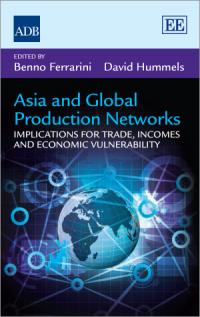That’s the title of a book edited by Benno Ferrarini (ADB) and David Hummels (Purdue).
From the Asian Development Bank’s website
Bringing to bear an array of the latest methods and data to study global value chains, the publication assesses the evolution of global value chains at the firm level, and how this affects competitiveness in Asia.
The publication has two broad themes. The first is national economies’ heightened exposure to adverse shocks (natural disasters, political disputes, recessions) elsewhere in the world as a result of greater integration and interdependence. The second theme is focused on the evolution of global value chains at the firm level and how this will affect competitiveness in Asia. It also traces the past and future development of production sharing in Asia.
The book can be downloaded from here [pdf].
Here is the link to the publisher, while a sample is here.
Contents:
- Foreword
Asia and Global Production Networks—Implications for Trade, Incomes and Economic Vulnerability, Benno Ferrarini and David Hummels
- Developing a GTAP-Based Multi-Region, Input-Output Framework for Supply Chain Analysis, Terrie L. Walmsley, Thomas Hertel, and David Hummels
- The Vulnerability of the Asian Supply Chain to Localized Disasters, Thomas Hertel, David Hummels and Terrie L. Walmsley
- Global Supply Chains and Natural Disasters: Implications for International Trade, Laura Puzzello and Paul Raschky
- Vertical Specialization, Tariff Shirking and Trade, Alyson C. Ma and Ari Van Assche
- Changes in the Production Stage Position of People’s Republic of China Trade, Deborah Swenson
- External Rebalancing, Structural Adjustment, and Real Exchange Rates in Developing Asia, Andrei Levchenko and Jing Zhang
- Global Supply Chains and Macroeconomic Relationships in Asia, Menzie Chinn (working paper version here)
- Mapping Global Value Chains and Measuring Trade in Tasks, Hubert Escaith
- The Development and Future of Factory Asia, Richard Baldwin and Rikard Forslid

From Judith Levine :
Feminism can’t handle the truth.
A woman saying ‘feminism’ can’t handle the truth. Since Menzie is a staunch supporter of any and all feminism, what will Menzie do now, now that women are confronting the evils within feminism?
From the Asian Development Bank: The first is national economies’ heightened exposure to adverse shocks (natural disasters, political disputes, recessions) elsewhere in the world as a result of greater integration and interdependence.
A rhetorical question: Why do people who write such things always imply that “political disputes” and “recessions” are external to “national economies?” Spoiler alert: political disputes and recessions are caused by governments who cause the disasters that face national economies. Why rhetorical? Politicians love being exempted from responsibility and the politicians hire these people.
China: Turning away from the dollar
http://www.ft.com/intl/cms/s/0/4ee67336-7edf-11e4-b83e-00144feabdc0.html#axzz3LTlSknNf
Jeffery,
Good article. I don’t think there is any threat from China. Any threat will be the US response to China. If the US attempts to continue business as usual manipulating the currency for illusionary gains then the changes China makes will create all kinds of problems. As your article notes relying on China and others to finance US debt could be a serious problem. Actually the government financial decision makers will have to totally relearn real economics because the illusionary economics will cease to bring a return. Actually, that is the primary reason China is taking these steps. If the US was no manipulating the world monetary system China would have no reason because there would be no gain.